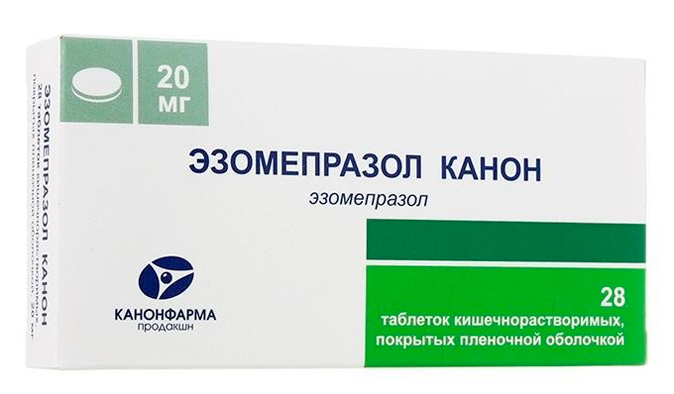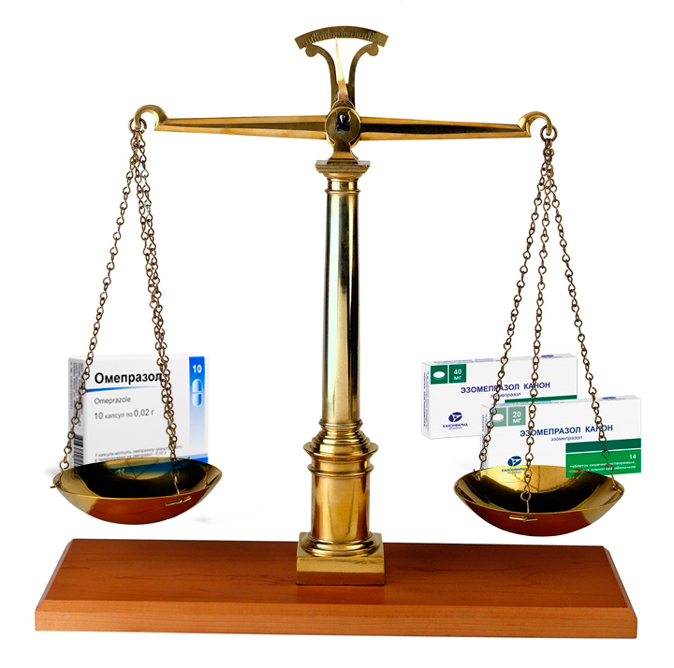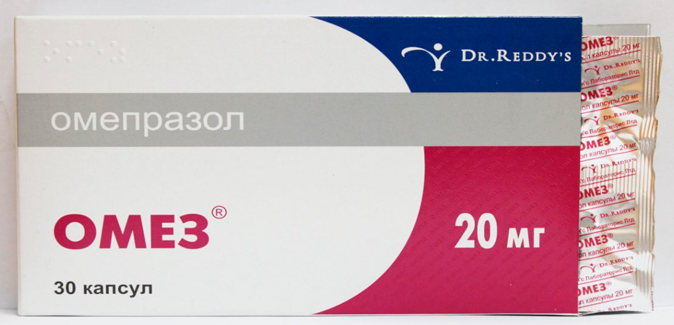These days it is not so often to meet a completely healthy person. Most often, due to malnutrition, stress and a sedentary lifestyle, the gastrointestinal tract suffers. , gastritis, stomach ulcers - this is not a complete list of diagnoses that each of us has heard at least once in our lives.
For the treatment of inflammatory processes in the stomach, drugs belonging to the group "proton pump inhibitors" are used. These drugs contain various active ingredients, such as omeprazole or esomeprazole. What is the difference between them? Consider the example of drugs of the same name.
Before comparing two drugs, you need to familiarize yourself with each of them.
Omeprazole is an active substance that blocks the work of cells responsible for the production of hydrochloric acid in the stomach. On its basis, both the drug of the same name and are produced.
The mechanism of action of omeprazole is quite simple: once in the human body, it acts on parietal cells, inhibiting the production of acid. Due to the accumulation of the substance in these cells, the effect of taking Omeprazole persists for about five to seven days after the end of the intake.
In addition, omeprazole has a neutralizing effect, reducing the acidity of existing gastric juice. Together, this creates a favorable environment for the restoration of damaged mucosa, scarring of ulcers, and healing of erosions.
The main indications for taking "omeprazole" are the following diseases:
- Ulcer of the stomach, duodenum, including those provoked by stress, taking medications;
- Reflux esophagitis;
- Tumor of the islet apparatus of the pancreas.
The action of the drug begins after the patient drinks the Omeprazole capsule, the effect will last for about a day.
When prescribing the drug, it should be borne in mind that the excretion of omeprazole from the body creates an unnecessary burden on the liver, so it should be used with caution in people suffering from liver failure.
Contraindications to taking the drug are intolerance to the components, the patient's age is under 18 years, pregnancy, breastfeeding.
"Esomeprazole": brief information about the drug
This drug belongs to the same group of antiulcer drugs as Omeprazole, however, the basis here is another active ingredient - esomeprazole. Due to its properties to block the secretion of hydrochloric acid, it is used to treat diseases such as:
- stomach and duodenal ulcers, including: caused by Helicobacter pylori or associated with taking NSAIDs;
- peptic ulcers (prevention of recurrence caused by Helicobacter pylori), prevention of recurrence of repeated bleeding;
- Zollinger-Ellison syndrome and other conditions characterized by increased gastric secretion, incl. idiopathic hypersecretion.
Contraindications to taking "Esomeprazole" are:
- Hypersensitivity to esomeprazole or other substances in the composition of the drug;
- Simultaneous appointment with the drugs "atazanavir" and "nelfinavir";
- Glucose-galactose malabsorption;
- Children under the age of 12 are strictly prohibited, in the period from 12 to 18 - in some cases, on the recommendation of a doctor;
- It is not recommended during pregnancy and lactation, since there are no official data on the safety of the drug for the child.

Comparison of Esomeprazole and Omeprazole
Both of these drugs have similar indications for use, but in some ways they still differ. To understand the difference, let's look at them in more detail:
Manufacturer and price
Omeprazole is represented on the domestic market by manufacturers from various countries (Russia, Serbia, Israel). The cost of one pack depends on the dosage and is about 30-150 rubles. "Esomeprazole" is also produced in Russia, but its cost is higher - 250-350 rubles for packing.
active ingredient
Esomeprazole is an isotope of omeprazole (S-form). These two substances differ in the structure of molecules - omeprazole and esomeprazole mirror each other.
Release form
Omeprazole is available in the form of hard gelatin capsules, while Esomeprazole is produced in the form of tablets. The dosage for both drugs is 20 and 40 mg.
Contraindications
"Omeprazole" is very versatile, its popularity is due to the fact that there are few contraindications to its use. It is prohibited for use by young children, people with intolerance to omeprazole and other components of the drug, as well as pregnant and lactating women.
In exceptional cases, when it comes to serious medical indications, Omeprazole can be prescribed to children aged four years and older, as well as to expectant mothers, however, this is rather an exception to the rule.
Neither "Omeprazole" nor "Esomeprazole" should be thoughtlessly used in renal and hepatic insufficiency, since the removal of these compounds from the body imposes an additional burden on these organs, which can lead to side (including severe) effects.
Side effects
In any instructions for Omeprazole, you can read a fairly impressive list of side effects, after reading which it will become scary to take such a dangerous drug. At the same time, one can hear the opinion that Omeprazole is well tolerated by most patients. How is such a contradiction possible?
The thing is that the manufacturer is obliged to indicate all possible reactions, even if isolated cases of their occurrence have been recorded. As a rule, all severe reactions to taking "Omeprazole" developed in seriously ill patients against the background of other diseases of the liver, nervous system, etc.
Most often, treatment with Omeprazole passes without any negative reactions. Those that do occur go away quickly without any special treatment.
So, most often against the background of taking Omeprazole, pain in the head, upset stool, nausea, and abdominal pain may occur. Even rarer, less than 1% cases of admission, sleep disturbance, itching and rashes on the skin, swelling of the extremities are observed.
In the list of possible side effects from taking Esomeprazole, you can also see disorders from:
- blood and lymphatic system;
- immune system;
- metabolism and nutrition;
- nervous system;
- organs of hearing, respiration, skin;
- hepatobiliary disorders;
- muscle and bone-articular changes;
- renal disorders;
- reproductive and sexual sphere;
But still, most often, less than every tenth patient, gastrointestinal disorders are observed, which disappear immediately after discontinuation of the drug.
Interaction with other drugs
Observations of patients who took "Omeprazole" showed that when taking a dose of the drug in the amount of 20 mg / day, no effect on plasma concentration of most other medicinal substances was observed.
The only group of drugs with which it is undesirable to take Omeprazole at the same time are those whose absorption depends on the pH value, since their effectiveness decreases if they are taken together. Esomeprazole works the same way.

Summing up the above, it is impossible to unequivocally answer the question of which of the drugs is better. Based on the practice of application, we can say that the use of "Esomeprazole" in the treatment of reflux disease is more effective.
However, in the case of the treatment of peptic ulcer, the results of the use of both drugs are approximately the same. The main difference is the price of the drug, and also (if we talk about Omeprazole of Israeli and Serbian production) the country of production.
In addition, the individual characteristics of the patient's body are an important factor. That is why the decision on the choice of the drug should be made by the attending physician, taking into account the financial capabilities of the patient.
Read more:


